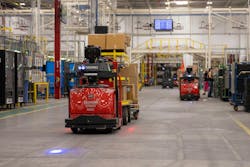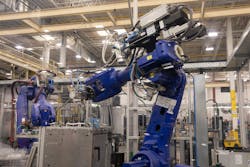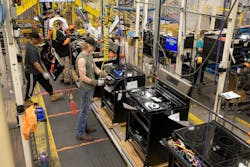GE Appliances Practices Lean Technology Strategy
When GE Appliances redesigned one of its freestanding range platforms, Luther Ingram, president and executive director at Roper Corporation and plant manager at Ropers’s facility in LaFayette, Georgia, decided it was also time to redesign the manufacturing lines that produced the ovens.
“Had we not been redesigning a product that had been 30-plus years old, we probably would have continued to just make small changes [to the lines]. But as we went and did a full model change, it gave us an opportunity here,” Ingram says.
Previously the line had been more ad hoc, according to Ingram, “a little bit here, a little bit there, stretched across this, stretched across there.” He wanted to consolidate the stations into a pair of contiguous lines and simultaneously introduce fresh technologies.
The Roper plant now features two 500-foot-long assembly lines that begin with the base range platform and, by adding the correct components, can manufacture gas, electric or induction ovens. Robot arms from ABB pick up and reposition oven cavities and cooktops. Metrology equipment measures assembly of precision.
It previously took 20 operators to assemble the main oven tops. Now only five operators work the line, mostly loading and unloading the robot cells, with the other 15 people reassigned to different lines elsewhere in the plant.
“We’re in a community of about 7,000, and we employ a little over 2,500. Although we continue to grow in volume, we can’t continue to grow in population. When you look at the state of Georgia and how manufacturing is coming into Georgia, many of the manufacturers are seeing the same challenges with the labor market,” says Ingram.
Lean Principles Drive Technology Choices
Bill Good, VP of supply chain at GE Appliances, says the company’s automation strategy invokes lean principles and a focus on critical-to-quality items.
“We've had the luxury of having Toyota [tour our plants] and being able to benchmark…to really get the best practices and integrate them into our manufacturing practices. A number of us also came from Whirlpool Corporation, Luther and myself included, where we had learned best practices for operator safety, and we've integrated those as well,” says Good.
According to Good, GEA consistently evaluates manual operations as “Ergo green” or “Ergo red” and automates tasks that fall into the “red” category. The company also uses virtual twins of shop floor layouts to plan equipment locations and simulate operations, to assess whether workers have to excessively stoop or reach.
The ABB robots on the new oven manufacturing lines address ergonomics, for example. They also, along with the new metrology equipment, improve accuracy.
“We can get a level of precision with a robot that you can't quite get with an operator over the course of an eight-hour shift. They may start out well, but due to fatigue they lose that level of precision,” Good says.
Why Drive When You Can Robot?
The new oven manufacturing lines also use automated guided vehicles (AGV) and autonomous mobile robots (AMR) for intra-plant material transport. The AGVs pull trains of product along multi-stop paths while the AMRs operate in small spaces, transporting light components.
“As we continue to drive safety inside manufacturing operations, we want to remove forklift and pedestrian interactions, and so that's how this grew into this AGV and AMR investment,” says Ingram.
The AGVs and AMRs, originally installed in 2024 only to serve the new oven manufacturing lines, now operate at 30% of all lines at the plant. The deployments also created a new position at the plant, a “robot wrangler” that programs the machines, provides safety training for operators and determines the best new deployments across the plant to create the most value.
“Automating the movement of that material, we want to be super-efficient. The days of just having forklift drivers and tugger drivers mindlessly pulling parts and inventory around, we're attempting to automate that so that we can put drivers in jobs where they add value,” says Good.
Don’t Drown in Technology Choices
Every time GEA successfully deploys new technology, the company adds to its portfolio of potential tech options for all its plants. Good says the Roper plant benefited from learnings at GEA’s laundry and dishwasher machine plants. Learnings about AMRs and AGVs from Roper will influence whether and how the machines deploy at plants in the future.
As the portfolio of proven technologies grows, GEA has to budget increased CapEx for each plant to plan for potentially deploying an increased number of solutions.
“It's less about using multiple technologies across the new plant, and more about how many applications we think we can leverage that drives the CapEx spend. [That said], part of our factory master plan is a very detailed strategic outlook over the next five years or so for a plant, and what we're attempting to do in those plants to make them more efficient, make our products higher quality and then plan out robotics integration, digitization integration and so forth. Typical CapEx spend does tend to increase as you want to automate more across the various programs,” says Good.
“That's where using data comes into play…one problem that may be here at Roper may not be the same problem at our laundry facility. We're going to implement based off need, based off the data and where it tells us we need to drive. Yes, we should be budgeting for some increase in automation, but that increase in automation is truly going to be based off of the need for each site,” says Ingram.
Incremental Change Isn’t Always Best
The improvements to the pair of oven manufacturing lines began in 2023, but full production didn’t begin until 2025. Startup and stabilization of the new lines was slower than expected. Introducing a large number of new solutions while also designing a line to support a brand-new product made the project challenging.
“Not only were we learning about the new product and how it goes together, now we're learning also about this robot, or the integration of how interlocking DC guns interact with this new assembly line, or maybe even how we test our product. We introduced a lot of change, all in one lump sum” says Ingram.
“If I could do it all over again, I may have said we would have introduced certain technologies incrementally. But there's also a piece of me that says to rip the band aid off, and had we not…we may still be talking about incremental growth right now, whereas what I can tell you is, although our first year was a learning year, our lines are now stable and are running at record rates than what we've historically seen.”
About the Author
Dennis Scimeca
Dennis Scimeca is a veteran technology journalist with particular experience in vision system technology, machine learning/artificial intelligence, and augmented/mixed/virtual reality (XR), with bylines in consumer, developer, and B2B outlets.
At IndustryWeek, he covers the competitive advantages gained by manufacturers that deploy proven technologies. If you would like to share your story with IndustryWeek, please contact Dennis at [email protected].





